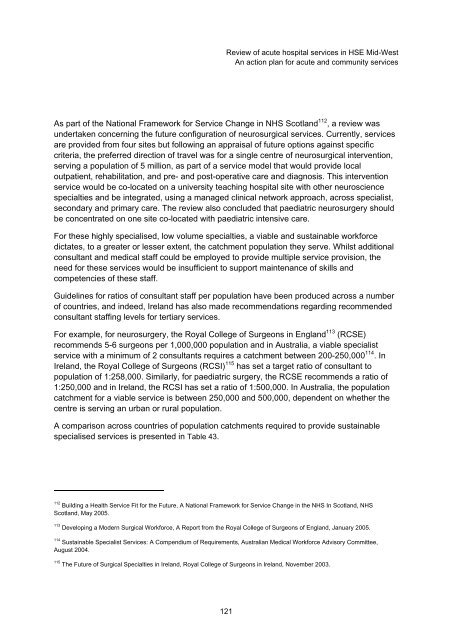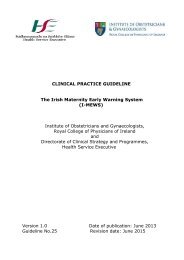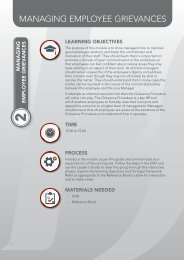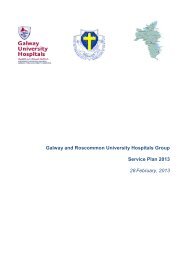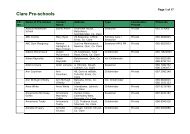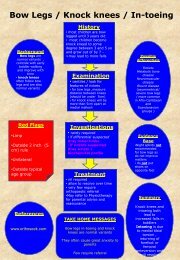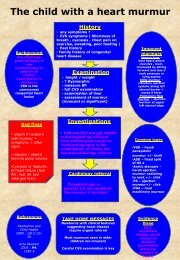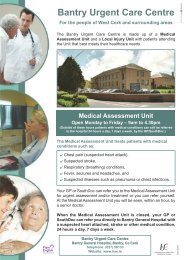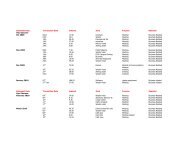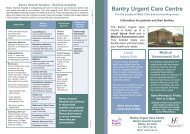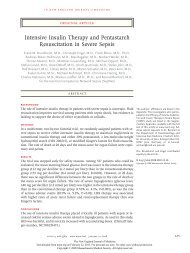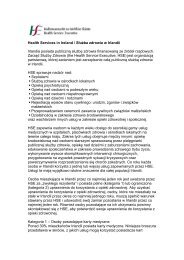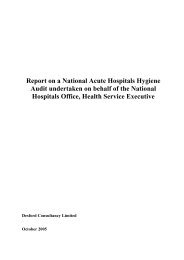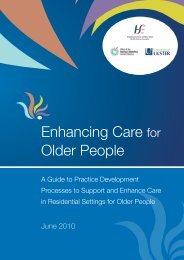Review of acute hospital services in the Mid - Health Service Executive
Review of acute hospital services in the Mid - Health Service Executive
Review of acute hospital services in the Mid - Health Service Executive
- TAGS
- acute
- www.hse.ie
You also want an ePaper? Increase the reach of your titles
YUMPU automatically turns print PDFs into web optimized ePapers that Google loves.
<strong>Review</strong> <strong>of</strong> <strong>acute</strong> <strong>hospital</strong> <strong>services</strong> <strong>in</strong> HSE <strong>Mid</strong>-West<br />
An action plan for <strong>acute</strong> and community <strong>services</strong><br />
As part <strong>of</strong> <strong>the</strong> National Framework for <strong>Service</strong> Change <strong>in</strong> NHS Scotland 112 , a review was<br />
undertaken concern<strong>in</strong>g <strong>the</strong> future configuration <strong>of</strong> neurosurgical <strong>services</strong>. Currently, <strong>services</strong><br />
are provided from four sites but follow<strong>in</strong>g an appraisal <strong>of</strong> future options aga<strong>in</strong>st specific<br />
criteria, <strong>the</strong> preferred direction <strong>of</strong> travel was for a s<strong>in</strong>gle centre <strong>of</strong> neurosurgical <strong>in</strong>tervention,<br />
serv<strong>in</strong>g a population <strong>of</strong> 5 million, as part <strong>of</strong> a service model that would provide local<br />
outpatient, rehabilitation, and pre- and post-operative care and diagnosis. This <strong>in</strong>tervention<br />
service would be co-located on a university teach<strong>in</strong>g <strong>hospital</strong> site with o<strong>the</strong>r neuroscience<br />
specialties and be <strong>in</strong>tegrated, us<strong>in</strong>g a managed cl<strong>in</strong>ical network approach, across specialist,<br />
secondary and primary care. The review also concluded that paediatric neurosurgery should<br />
be concentrated on one site co-located with paediatric <strong>in</strong>tensive care.<br />
For <strong>the</strong>se highly specialised, low volume specialties, a viable and susta<strong>in</strong>able workforce<br />
dictates, to a greater or lesser extent, <strong>the</strong> catchment population <strong>the</strong>y serve. Whilst additional<br />
consultant and medical staff could be employed to provide multiple service provision, <strong>the</strong><br />
need for <strong>the</strong>se <strong>services</strong> would be <strong>in</strong>sufficient to support ma<strong>in</strong>tenance <strong>of</strong> skills and<br />
competencies <strong>of</strong> <strong>the</strong>se staff.<br />
Guidel<strong>in</strong>es for ratios <strong>of</strong> consultant staff per population have been produced across a number<br />
<strong>of</strong> countries, and <strong>in</strong>deed, Ireland has also made recommendations regard<strong>in</strong>g recommended<br />
consultant staff<strong>in</strong>g levels for tertiary <strong>services</strong>.<br />
For example, for neurosurgery, <strong>the</strong> Royal College <strong>of</strong> Surgeons <strong>in</strong> England 113 (RCSE)<br />
recommends 5-6 surgeons per 1,000,000 population and <strong>in</strong> Australia, a viable specialist<br />
service with a m<strong>in</strong>imum <strong>of</strong> 2 consultants requires a catchment between 200-250,000 114 . In<br />
Ireland, <strong>the</strong> Royal College <strong>of</strong> Surgeons (RCSI) 115 has set a target ratio <strong>of</strong> consultant to<br />
population <strong>of</strong> 1:258,000. Similarly, for paediatric surgery, <strong>the</strong> RCSE recommends a ratio <strong>of</strong><br />
1:250,000 and <strong>in</strong> Ireland, <strong>the</strong> RCSI has set a ratio <strong>of</strong> 1:500,000. In Australia, <strong>the</strong> population<br />
catchment for a viable service is between 250,000 and 500,000, dependent on whe<strong>the</strong>r <strong>the</strong><br />
centre is serv<strong>in</strong>g an urban or rural population.<br />
A comparison across countries <strong>of</strong> population catchments required to provide susta<strong>in</strong>able<br />
specialised <strong>services</strong> is presented <strong>in</strong> Table 43.<br />
112<br />
Build<strong>in</strong>g a <strong>Health</strong> <strong>Service</strong> Fit for <strong>the</strong> Future, A National Framework for <strong>Service</strong> Change <strong>in</strong> <strong>the</strong> NHS In Scotland, NHS<br />
Scotland, May 2005.<br />
113 Develop<strong>in</strong>g a Modern Surgical Workforce, A Report from <strong>the</strong> Royal College <strong>of</strong> Surgeons <strong>of</strong> England, January 2005.<br />
114<br />
Susta<strong>in</strong>able Specialist <strong>Service</strong>s: A Compendium <strong>of</strong> Requirements, Australian Medical Workforce Advisory Committee,<br />
August 2004.<br />
115 The Future <strong>of</strong> Surgical Specialties <strong>in</strong> Ireland, Royal College <strong>of</strong> Surgeons <strong>in</strong> Ireland, November 2003.<br />
121


